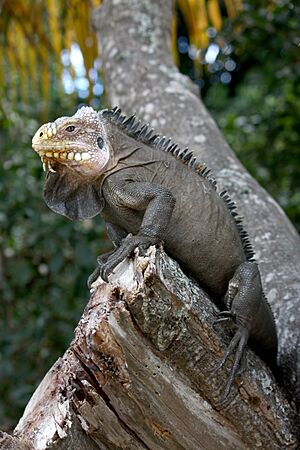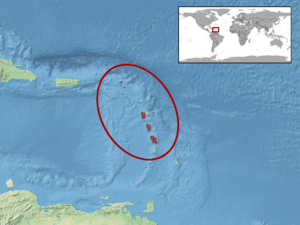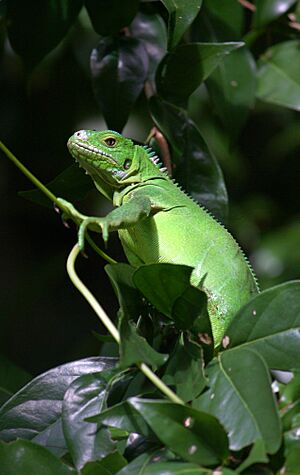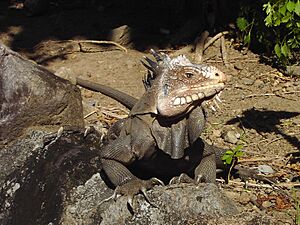Lesser Antillean iguana facts for kids
Quick facts for kids Lesser Antillean iguana |
|
|---|---|
 |
|
| A Lesser Antillean iguana in Coulibistrie, Dominica | |
| Conservation status | |
| Scientific classification | |
| Genus: |
Iguana
|
| Species: |
delicatissima
|
 |
|
The Lesser Antillean iguana (Iguana delicatissima) is a large tree-dwelling lizard. It lives only on the Lesser Antilles islands. This iguana is one of three types of lizard in the Iguana family.
Sadly, its numbers are dropping fast. This is because its home is being destroyed. Also, new animals like feral dogs and cats are hunting them. People sometimes hunt them too. Another big problem is that they are mixing with green iguanas (Iguana iguana). Green iguanas are not native to these islands.
This iguana is also known as the Lesser Antillean green iguana or West Indian iguana.
Contents
What's in a Name?
The name iguana comes from iwana. This was the name the Taíno people used for this animal. The word delicatissima is Latin. It means "delicate" or "very fine." An Austrian naturalist named Josephus Nicolaus Laurenti first described this species in 1768.
How to Spot a Lesser Antillean Iguana

The Lesser Antillean iguana has a shorter, blockier face. It does not have the stripe pattern on its tail that the green iguana has. The easiest way to tell them apart is a large, round scale. The green iguana has this scale below each ear hole. The Lesser Antillean iguana does not have it.
Their color can be different depending on the island. But they are usually gray with green spots on their belly. They have large, pale, ivory-colored scales on their heads. Male iguanas have pink jowls. The scales around their eyes are blue. Males also have special pores on their inner thighs. These pores release scents during breeding season.
Males are bigger than females. They can grow to about 40 cm (16 in) long. Their tail can be another 80 cm (31 in) long. Females are about two-thirds the size of males.
Where Do Lesser Antillean Iguanas Live?
These iguanas live in scrub woodlands, rainforests, and mangroves. You can find them on islands like Saint Barth, Anguilla, St. Eustatius, Guadeloupe, Dominica, and Martinique.
In the past, they lived on more islands. But since Europeans settled, they have disappeared from places like Sint Maarten, Saint Kitts, Nevis, Barbuda, Antigua, Marie Galante, and Îles des Saintes.
What Do Lesser Antillean Iguanas Eat?
Lesser Antillean iguanas are mostly herbivores. This means they eat plants. They munch on leaves, flowers, seeds, fruits, and new shoots. They eat from over 100 different kinds of plants.
They even eat the manchineel tree (Hippomane mancinella). This tree has chemicals that are poisonous to many animals. During the wet season (August to December), they eat many leaves and fruits. These fruits include Barbados cherry and manchineel. In the dry season (January to May), they eat more leaves than fruit. They often eat fruits from the chink bush (Bourreria succulenta).
Why This Iguana Needs Our Help
The Lesser Antillean iguana is a critically endangered species. This means it is at very high risk of disappearing forever. It is listed on the IUCN Red List. Laws protect these iguanas from hunting. But it is hard to make sure these laws are followed.
Other dangers include losing their homes. Their habitats are cleared for farms and buildings. Also, wild animals like dogs, cats, and mongooses hunt them.
The biggest threat comes from their own relative, the green iguana. Green iguanas were brought to the Lesser Antilles. They are an invasive species. This means they are not native and cause harm. They compete with the Lesser Antillean iguana for food and space.
Even worse, green iguanas are interbreeding with the Lesser Antillean iguanas. This mixing has caused the native iguanas to decline or disappear on many islands. For example, on Anguilla, green iguanas arrived after hurricane Luis in 1995. Within 20 years, the native Lesser Antillean iguana population was gone.
Recently, non-native iguanas also reached Dominica. This island was the last major safe place for the species. These iguanas arrived with hurricane aid supplies after Hurricane Maria in 2017.
Some Lesser Antillean iguanas are kept in zoos and wildlife centers. These include the Durrell Wildlife Conservation Trust, the Chester Zoo, the Memphis Zoo, and the San Diego Zoo. All these iguanas came from Dominica. It is hard to breed and keep them in captivity. Many eggs laid in zoos are not fertile. However, some successes have happened. One iguana hatched at Durrell in 1997. Eight more hatched in 2000. In 2016, 11 iguanas hatched at Durrell. These will go to zoos across Europe to help with conservation. In 2018, four iguanas from Sint Eustatius went to Blijdorp zoo in Rotterdam, Netherlands, for a breeding program.



